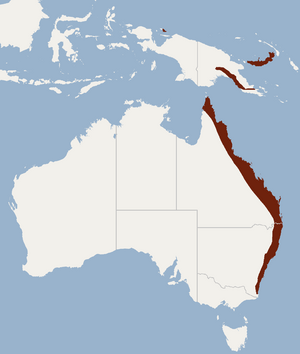Golden-tipped bat facts for kids
Quick facts for kids Golden-tipped bat |
|
|---|---|
| Conservation status | |
| Scientific classification | |
| Genus: |
Phoniscus
|
| Species: |
papuensis
|
 |
|
| Synonyms | |
|
Kerivoula papuensis Dobson, 1878 |
|
The golden-tipped bat (Kerivoula papuensis) is a small type of bat. It belongs to a family of bats called Vespertilionidae. You can find it in Papua New Guinea and in eastern Australia. This bat is quite rare. In Australia, it is even listed as an endangered animal.
Contents
About the Golden-tipped Bat
The golden-tipped bat has brown fur that looks woolly. Its fur has broken color patterns. These patterns help the bat hide in its surroundings. The thick, woolly fur also helps keep the bat warm. Adult bats usually weigh about 6.7 grams.
Wings and Flight
This bat has wide wings with a low aspect ratio. This means its wings are broad, which helps it fly slowly. It also has a large tail membrane. This membrane works with the wings to help the bat make sharp turns while flying. The rounded tips of its wings also help it move very well in the air.
Echolocation
Golden-tipped bats use echolocation to find their way and hunt for food. They send out high-pitched sounds. These sounds bounce off objects and come back to the bat. This helps them create a sound map of their surroundings. Their echolocation sounds range from about 155 kHz to 60 kHz.
Where Golden-tipped Bats Live
Golden-tipped bats mostly live in rainforests or wet sclerophyll forests. They have also been seen in dry sclerophyll forests. These bats can live at heights up to 1,000 meters above sea level.
Where They Rest During the Day
During the day, these bats rest in places called roosts. They often choose tree branches or hollows in trees. Their roosts are usually between 0.5 and 9.0 meters above the ground. Female bats use the tops of trees as special places to raise their babies. Their broken fur patterns help them hide from animals that might try to eat them.
What Golden-tipped Bats Eat
Golden-tipped bats mainly eat spiders, especially orb-weaver and big-jawed spiders. Scientists know this because they find tiny pieces of spider bodies stuck in the bats' teeth and fur. Even though spiders are their main food, these bats also eat insects. They sometimes eat beetles and butterflies and moths.
How They Hunt for Food
Golden-tipped bats use different ways to hunt. One way is called "ground gleaning." This means they pick up prey from the ground. They also "hover-glean." This is when they fly slowly and take prey from high places, like tree trunks.
They use their wide-ranging echolocation sounds to find their prey very accurately. They also use high-frequency echolocation to find prey that isn't moving, like spiders sitting on their webs.
See also
 In Spanish: Phoniscus papuensis para niños
In Spanish: Phoniscus papuensis para niños


